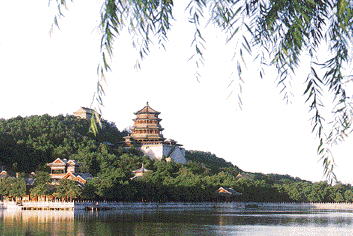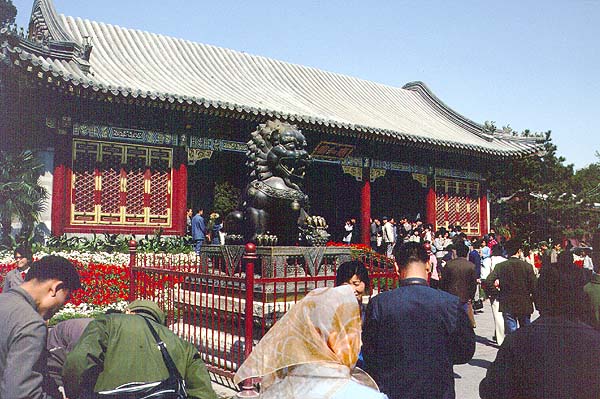Klik - under
teksten for at komme videre!
Summer Palace
The Summer Palace lies in the northwestern outskirts of Beijing, about 5 kilometers northwest of Beijing University. Occupying an area of 290 hectares, approximately the size of seven Tian'anmen Square, the gardens consist mainly of a hill, the Longevity Hill (Wanshoushan) and a lake, the Kunming Lake, with halls, towers, galleries, pavilions, bridges and islands dotted all over the land, hill and lake. Blending southern China-style garden architecture with northern China's natural landscapes, the gardens are probably the best of their kind in Chinese garden architecture.

The history of the gardens goes back to the Mongolian Yuan Dynasty in the 13-14th
century. At that time, the Longevity Hill was called Jar Hill (Wengshan) and the Kunming
Lake was known as Jar Hill Pond (Wengshanpo). A famous hydraulic engineer called Guo
Shoujing succeeded in bringing water from Changping in the northern outskirts and the Jade
Spring Hill to the west of the Summer Palace to the pong which was expanded into a large
reservoir known as the West Lake.
The area remained ignored for centuries until in the 17th century the Qing rulers
decided to turn the area between the city and the West Hills into a vast pleasure ground
which was known as "three hills and five gardens". They were Garden of
Everlasting Spring (Changchunyuan) and Garden of Perfection and Brightness (Yuanmingyuan);
Garden of Tranquillity and Brightness (Jingmingyuan) at Jade Spring Hill; Garden of
Tranquillity and Pleasure (Jingyiyuan) at Fragrant Hills; and Garden of Clear Ripples
(Qingyiyuan) at Longevity Hill (Wanshoushan) which was the predecessor of Yiheyuan.
In 1750, a large construction was started to expand Qingyiyuan to celebrate the
60th birthday of the emperor's mother. The construction centred on the Temple of Gratitude
for Longevity (Dabaoen Yanshousi) at the West Lake. Wengshan was renamed Longevity Hill
(Wanshoushan) and the West Lake became Kunming Lake after a well-known lake in Chang'an
during the Tang Dynasty.
In 1860, an Anglo-French joint force invaded Beijing, plundered the treasures in
the imperial gardens and set fire to them. The only buildings which survived at the Summer
Palace were non-wooden structures such as the Bronze Pavilion on the hill, the Marble Boat
and the Sea of Wisdom (a glazed-tile archway), which you may see during your visit to the
garden.
During the Anglo-French invasion, the Qing emperor, Xianfeng, fled to Rehe (today's
Chengde) where his summer resort was and died there the following year. He was succeeded
by his son, Emperor Tongzhi, when the little emperor was merely a six-year-old child. The
emperor's mother, Cixi, therefore became the Empress Dowager. To control the power
herself, Cixi conducted a coup d'etat by eliminating the appointed council of regents.
Emperor Tongzhi was short-lived and died before his 20th birthday in 1874. Cixi quickly
placed her sister's son, a four-year-old child, on the Dragon Throne, and she herself took
over the regency and continued to exercise great power behind the bamboo curtain until the
death of the emperor, Guangxu. Guangxu's father, Prince Zhu, was very loyal to Cixi and
was appointed chief of the Navy.
To curry favour with the Empress Dowager, Prince Chun began to restore Garden of
Clear Ripples (Qingyiyuan then renamed Yiheyuan) under the pretext of setting up a naval
academy there and using the money for building a Chinese fleet. This lack of a
well-trained navy was the cause of China's defeat in the Sino-Japanese war of 1895.
Visitors to the Summer Palace may find an iron boat on the shore behind the Marble Boat,
which was supposed to be used for navy training, and ask themselves how could a toy like
that be used to fight the Japanese.
The restoration lasted for nearly 10 years and was completed by 1895. Cixi moved to
live in the Summer Palace in 1889, and Emperor Guangxu was imprisoned there by her after
he launched an unsuccessful attempt at reform in 1898. The allied forces of the eight
powers invaded Beijing in 1900, and the garden was severely damaged once again, when the
Empress Dowager and Guangxu fled to Xi'an. After their return to Beijing, Cixi allocated a
great deal of money for further restoration.
The Empress Dowager lived most of her later years in the Summer Palace, which then
became not only her summer resort and pleasure garden, but the secondary imperial palace
for administration. Such large gardens were solely for herself and the emperor. It was
said that the kitchens occupied 8 courtyards and 128 kitchen eunuchs prepared food just
for her. An opera staged on the Grand Theatre at the Garden of Virtue and Harmony
(Deheyuan) spent over 500,000 taels of silver on stage props alone. To celebrate her 60th
birthday in 1894, Cixi drew more than 5 million taels of silver from the state treasury
for the event. The marquee set up in front of the Hall of Benevolent Longevity used over
200 kilometers of coloured silk.

After the death of Cixi, the Summer Palace was closed down by Guangxu's empress.
The Revolution of 1911 overthrew the Qing empire, but the Summer Palace still belonged to
the imperial family according to the Article of Favourable Treatment. The garden was
opened by the imperial family in 1914 to the public for an entrance fee. After the last
emperor was driven out of Beijing, it was turned into a public park.
Since 1949, more renovations have been carried out, and maintenance in the gardens
has been on a regular basis. Even during the "cultural revolution ", the Summer
Palace was well preserved and still open to the public, being used for class education as
an example to criticize the feudal rulers.
Now it is one of the main tourist spots in Beijing, and receives over five million
visitors a year.
Like most imperial palaces in China, the Summer Palace is divided into three parts:
halls for political affairs, living quarters and religious buildings.